- Accueil
- Pages cachées
- 17 SEPTEMBRE 2023 NEWS
17 SEPTEMBRE 2023 NEWS
INSTITUIT SUPERIEUR D'ANTHROPOLOGIE
INSTITUT OF ANTHROPOLOGY
COURS ONLINE – COURS A DISTANCE
INSCRIPTIONS : SEPTEMBRE 2023
REGISTER NOW
TURQUIE –  Geçitli - It was revealed that in the Besni district of Adıyaman province, located in the Southeastern Anatolia Region of Turkey, the Romans dug a 150-meter-long water tunnel into the mountain 1,700 years ago to irrigate their lands with the water flowing from the river. An interesting 1,700-year-old structure dating back to the Roman Period was identified in the mountainous area in the Kantara region within the borders of Geçitli (Kantara) village of Adıyaman’s Besni district. It has been determined that the tunnel, which is 150 meters long and 80 centimeters wide, and 1.5-2 meters high, was carved out by the Romans to transport water from the Sofraz River to the fields. The water canal constructed along the riverbank joins with the excavated water tunnel and extends to the agricultural lands to the south. In order to construct a significant number of water supply tunnels known as cuniculi in the northeast of Rome, the Etruscans adopted the qanat technique in the sixth century BCE. They later imparted their knowledge to the Romans, who built aqueducts using the qanat technique. Romans used a method known as “fire-quenching” to break hard rocks, which involved heating the rock with fire and then quickly cooling it with cold water. Hard rock could make progress extremely slow, and it was not unusual for tunnel construction to take years or even decades. It was stated that the tunnel is an important historical structure with its interesting structure. During the investigations carried out in the same region, living spaces and rock tombs dating back to the Roman period were found. Adıyaman Museum Director Mehmet Alkan emphasized the magnificent nature of the tunnel and stated, ” We discovered that this tunnel, which dates back to the 3rd century AD, or 1,700 years ago, was built to transport water from the Sofraz River to fields on the opposite side of the living area. We have witnessed how remarkable this water tunnel, built 1,700 years ago, appears. This tunnel, showcasing exceptional craftsmanship and serving as a remarkable piece of art, is the longest water tunnel found in Adıyaman” he said.
Geçitli - It was revealed that in the Besni district of Adıyaman province, located in the Southeastern Anatolia Region of Turkey, the Romans dug a 150-meter-long water tunnel into the mountain 1,700 years ago to irrigate their lands with the water flowing from the river. An interesting 1,700-year-old structure dating back to the Roman Period was identified in the mountainous area in the Kantara region within the borders of Geçitli (Kantara) village of Adıyaman’s Besni district. It has been determined that the tunnel, which is 150 meters long and 80 centimeters wide, and 1.5-2 meters high, was carved out by the Romans to transport water from the Sofraz River to the fields. The water canal constructed along the riverbank joins with the excavated water tunnel and extends to the agricultural lands to the south. In order to construct a significant number of water supply tunnels known as cuniculi in the northeast of Rome, the Etruscans adopted the qanat technique in the sixth century BCE. They later imparted their knowledge to the Romans, who built aqueducts using the qanat technique. Romans used a method known as “fire-quenching” to break hard rocks, which involved heating the rock with fire and then quickly cooling it with cold water. Hard rock could make progress extremely slow, and it was not unusual for tunnel construction to take years or even decades. It was stated that the tunnel is an important historical structure with its interesting structure. During the investigations carried out in the same region, living spaces and rock tombs dating back to the Roman period were found. Adıyaman Museum Director Mehmet Alkan emphasized the magnificent nature of the tunnel and stated, ” We discovered that this tunnel, which dates back to the 3rd century AD, or 1,700 years ago, was built to transport water from the Sofraz River to fields on the opposite side of the living area. We have witnessed how remarkable this water tunnel, built 1,700 years ago, appears. This tunnel, showcasing exceptional craftsmanship and serving as a remarkable piece of art, is the longest water tunnel found in Adıyaman” he said.
TURQUIE –  Kayalıpınar - A seal impression belonging to Hattusili III was found during the excavations carried out near the village of Kayalıpınar in Yıldızeli district of Sivas province, located in the central Anatolia region of Türkiye. Hattusili III, one of the most famous kings of the Hittites, took his place in history with the Battle of Kadesh and the subsequent Kadesh Peace Treaty. Not only was Hattusilis successful in his military exploits, both before and after his assumption of the kingship, he and his wife Puduhepa, instituted religious reforms within the Hittite kingdom and engaged in extensive diplomatic relations with other great powers of the time such as Egypt and Assyria. Hattusili III ruled the Hittite lands between 1267 and 1237 BC. Archaeologists have been excavating in Kayalipinar, a village in Yildizeli District in Sivas Province, since 2004. It was determined that this region, where many epigraphic findings were discovered, was one of the Hittite cities of the Imperial period. According to the Anadolu Agency, Dr. Çigdem Maner, Associate Professor of Koç University’s Department of Archeology and Art History, has been collaborating with international scientists, and the team is making significant progress at the excavation site. “Kayalipinar was previously known as a settlement from the Old Assyrian and Hittite periods. This year’s findings and architecture show that this settlement is actually much older and dates back to even later periods. We could understand that it lasted for about 1,000 years. These excavations prove that Kayalipinar was the center of millennia,” Maner said. Researchers have unearthed ancient seal impressions of King Hattusili III, his children, his wife Puduhepa, and princes, as well as clay seal prints belonging to the King’s eldest son, Crown Prince Nerikaili. Archaeologists also found pieces of cuneiform tablets with inscriptions of festivals and fortune-telling texts.
Kayalıpınar - A seal impression belonging to Hattusili III was found during the excavations carried out near the village of Kayalıpınar in Yıldızeli district of Sivas province, located in the central Anatolia region of Türkiye. Hattusili III, one of the most famous kings of the Hittites, took his place in history with the Battle of Kadesh and the subsequent Kadesh Peace Treaty. Not only was Hattusilis successful in his military exploits, both before and after his assumption of the kingship, he and his wife Puduhepa, instituted religious reforms within the Hittite kingdom and engaged in extensive diplomatic relations with other great powers of the time such as Egypt and Assyria. Hattusili III ruled the Hittite lands between 1267 and 1237 BC. Archaeologists have been excavating in Kayalipinar, a village in Yildizeli District in Sivas Province, since 2004. It was determined that this region, where many epigraphic findings were discovered, was one of the Hittite cities of the Imperial period. According to the Anadolu Agency, Dr. Çigdem Maner, Associate Professor of Koç University’s Department of Archeology and Art History, has been collaborating with international scientists, and the team is making significant progress at the excavation site. “Kayalipinar was previously known as a settlement from the Old Assyrian and Hittite periods. This year’s findings and architecture show that this settlement is actually much older and dates back to even later periods. We could understand that it lasted for about 1,000 years. These excavations prove that Kayalipinar was the center of millennia,” Maner said. Researchers have unearthed ancient seal impressions of King Hattusili III, his children, his wife Puduhepa, and princes, as well as clay seal prints belonging to the King’s eldest son, Crown Prince Nerikaili. Archaeologists also found pieces of cuneiform tablets with inscriptions of festivals and fortune-telling texts.
Archaeologists Found Seal Impressions That Could Change Hittite History in Kayalıpınar - Arkeonews
MEXIQUE – 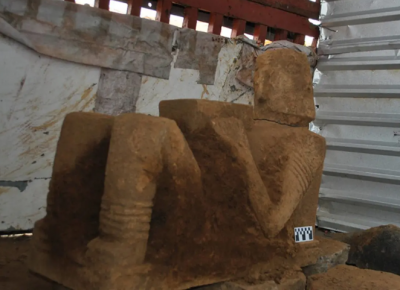 Pátzcuaro - Archaeologists recovered a chacmool statue in Pátzcuaro during construction works, which according to the researchers was found out of context from its original location and placed in construction fill for the development of the city. The statue is carved from basalt and measures 90 centimetres in length by 80 centimetres in height, with a preliminary study placing the date of the statue to the Late Post-Classic Period (AD 1350 to 1521). According to an INAH representative: “These images that we know by the Mayan name of chacmool were ritual tables in pre-Hispanic times. It has been speculated that they were used in sacrificial and offering ceremonies.” A chacmool is a distinctive form of Mesoamerican sculpture representing a reclining figure that may represent slain warriors carrying offerings to the gods. Individual chacmools exhibit significant variation, with heads that can face either to the right or left, and in some cases, upwards. The original name for these sculptures is unknown, with the name “chacmool” given by Augustus Le Plongeon in 1875 based on a sculpture he and his wife unearthed in the Temple of the Eagles and Jaguars at Chichén Itzá. Le Plongeon interpreted “Chaacmol” from Yucatecan Mayan to mean “paw swift like thunder.”
Pátzcuaro - Archaeologists recovered a chacmool statue in Pátzcuaro during construction works, which according to the researchers was found out of context from its original location and placed in construction fill for the development of the city. The statue is carved from basalt and measures 90 centimetres in length by 80 centimetres in height, with a preliminary study placing the date of the statue to the Late Post-Classic Period (AD 1350 to 1521). According to an INAH representative: “These images that we know by the Mayan name of chacmool were ritual tables in pre-Hispanic times. It has been speculated that they were used in sacrificial and offering ceremonies.” A chacmool is a distinctive form of Mesoamerican sculpture representing a reclining figure that may represent slain warriors carrying offerings to the gods. Individual chacmools exhibit significant variation, with heads that can face either to the right or left, and in some cases, upwards. The original name for these sculptures is unknown, with the name “chacmool” given by Augustus Le Plongeon in 1875 based on a sculpture he and his wife unearthed in the Temple of the Eagles and Jaguars at Chichén Itzá. Le Plongeon interpreted “Chaacmol” from Yucatecan Mayan to mean “paw swift like thunder.”
Archaeologists discover chacmool statue in Pátzcuaro | HeritageDaily - Archaeology News
MEXIQUE – 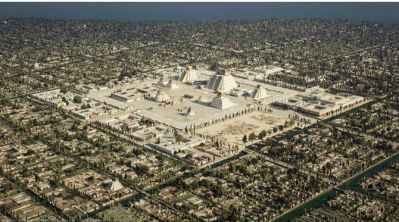 Tenochtitlan - The project, called “A portrait of Tenochtitlan, a 3D reconstruction of the capital of the Aztec Empire”, is the result of 1.5 years of study, in which a team of specialists have used open-source software such as Blender, Gimp, and Darktable, to bring Tenochtitlan back to life how it looked in AD 1518. Tenochtitlan was meticulously planned with a symmetrical layout, encompassing four distinct zones that covered an expanse of 3,212 acres. Each zone was subdivided into 20 calpulli (districts), interconnected by a network of tlaxilcalli (streets) leading to extensive causeways connecting to the mainland. Within each calpulli, a central tiyanquiztli (marketplace) was situated, accompanied by various residences and workshops for artisans such as weavers, sculptors, and potters. At the centre was a large ceremonial complex containing public buildings, temples, and palaces. “Large buildings stand out against the single-story houses, from the massive twin-temple pyramids in the centre, to the smaller temples and shrines in neighborhood community centres. The Sacred Precinct, with the Templo Mayor, forms the epicenter of the city. Next to it is the palace of Emperor Motecuhzoma Xocoyotzin, among various other temples, schools, gardens, and a zoo,” said Kole.
Tenochtitlan - The project, called “A portrait of Tenochtitlan, a 3D reconstruction of the capital of the Aztec Empire”, is the result of 1.5 years of study, in which a team of specialists have used open-source software such as Blender, Gimp, and Darktable, to bring Tenochtitlan back to life how it looked in AD 1518. Tenochtitlan was meticulously planned with a symmetrical layout, encompassing four distinct zones that covered an expanse of 3,212 acres. Each zone was subdivided into 20 calpulli (districts), interconnected by a network of tlaxilcalli (streets) leading to extensive causeways connecting to the mainland. Within each calpulli, a central tiyanquiztli (marketplace) was situated, accompanied by various residences and workshops for artisans such as weavers, sculptors, and potters. At the centre was a large ceremonial complex containing public buildings, temples, and palaces. “Large buildings stand out against the single-story houses, from the massive twin-temple pyramids in the centre, to the smaller temples and shrines in neighborhood community centres. The Sacred Precinct, with the Templo Mayor, forms the epicenter of the city. Next to it is the palace of Emperor Motecuhzoma Xocoyotzin, among various other temples, schools, gardens, and a zoo,” said Kole.
A Portrait of Tenochtitlan • 3D reconstruction of the capital of the Aztec empire. (thomaskole.nl)
INDE –  Mudu Konaje - Unique ancient terracotta figurines in different stages of preservation, with bone and iron pieces, have been found in recent archaeological explorations conducted at Mudu Konaje near Moodbidri in Dakshina Kannada district of Karnataka. The figurines can be dated back to 800-700 BCE, said T Murugeshi, Retired Associate Professor at Department of Ancient History and Archaeology at Mulki Sunder Ram Shetty college, Shirva in Udupi district. Of the eight figurines found, there are those representing two bovines, one mother goddess, two peacocks, a horse, a hand of a mother goddess and an unknown object. The terracotta figurines found at Mudu Konaje in a megalithic context are a rare find of India. They were found inside the surface of dolmens, which were disturbed by treasure hunters. The bovines found in the dolmens help to determine the chronology of the dolmens. Terracottas found in the megalithic burial provide a solid ground for the study of the Bhoota cult or Daivaradhane of coastal Karnataka. Cow bovine or cow goddess had its parallels in Malampuzha megalithic terracotta figurines of Kerala and Egypt.
Mudu Konaje - Unique ancient terracotta figurines in different stages of preservation, with bone and iron pieces, have been found in recent archaeological explorations conducted at Mudu Konaje near Moodbidri in Dakshina Kannada district of Karnataka. The figurines can be dated back to 800-700 BCE, said T Murugeshi, Retired Associate Professor at Department of Ancient History and Archaeology at Mulki Sunder Ram Shetty college, Shirva in Udupi district. Of the eight figurines found, there are those representing two bovines, one mother goddess, two peacocks, a horse, a hand of a mother goddess and an unknown object. The terracotta figurines found at Mudu Konaje in a megalithic context are a rare find of India. They were found inside the surface of dolmens, which were disturbed by treasure hunters. The bovines found in the dolmens help to determine the chronology of the dolmens. Terracottas found in the megalithic burial provide a solid ground for the study of the Bhoota cult or Daivaradhane of coastal Karnataka. Cow bovine or cow goddess had its parallels in Malampuzha megalithic terracotta figurines of Kerala and Egypt.
TURQUIE - 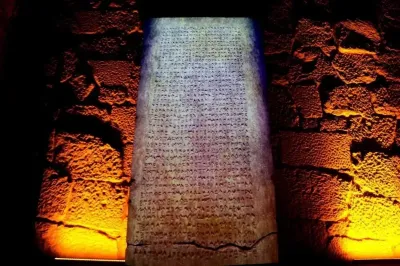 Andrake - A Customs Inscription from the Lycian civilization, located in Andriake port in the southern province of Antalya’s Demre district, tells about ancient times, and also reflects the importance of Türkiye’s geographical location in maritime trade thousands of years ago. The Ancient City of Andriake is 5 km away from the Demre district of Antalya. It was one of the most important ports of Lycia, such as Phaselis and Patara, in ancient times. It is known as the port of the Ancient City of Myra and a settlement formed by it, rather than being a separate city. The inscription, discovered in the vicinity of the largest Granarium in the Mediterranean, named after Emperor Hadrian (Horrea Hadriani), contains information about the Lycian Union Customs Laws, port usage rules and taxes, and those who brought goods through maritime trade.The Lycian League was founded with 23 cities along the Mediterranean’s Teke Peninsula. The league, known as history’s first democratic union, served as a model for modern democratic systems. Patara (the capital), Xanthos, Pinara, Olympos, Myra, and Tlos were among the major cities of this federation. “Understanding a port, especially the customs part, is a very important thing. We are following traces. We are trying to examine these traces both archaeologically and epigraphically with Associated Professor Burak Takmer, who is studying this famous inscription as his doctoral thesis,” Çevik said. While various structures such as the Granarium, Agora, baths, port shops, honorary monuments, five churches, shipyards were mostly unearthed during the excavations, the customs inscription is the focus of this year’s work. Takmer clarified the dating of the monument by determining that C. Licinius Mucianus, who is known to have been the Governor of the Lycian province during the reign of Emperor Nero, was mentioned in the third line. The first nine lines of the inscription, which is dated between 60-63 A.D. and consists of 87 lines, could not be evaluated accurately because the lines were severely damaged. However, the general content of the inscription was clarified that it contains the Customs Law of the Lycian State. The inscription contains articles of law on how the port will be used, how the taxes will be paid and what goods will be shipped. Speaking about the latest developments regarding the Andriake excavations, Çevik said that following the restoration work, the area turned into the Lycian Civilizations Museum, which is a great source of happiness for an archaeologist. Çevik stated that this year’s excavations continue in the Customs area and on Agora Street, and said, “A large inscription dating back to the reign of Emperor Nero, erected in 63 A.D., was found here. It is the Customs Laws of the Lycian Union. We are digging the structure of this inscription and the street where it is located. Since understanding the customs of a port is very important, we are pursuing new traces.” Çevik also underlined that the Andriake Port was an important port not only for Myra but also for the Lycian period.
Andrake - A Customs Inscription from the Lycian civilization, located in Andriake port in the southern province of Antalya’s Demre district, tells about ancient times, and also reflects the importance of Türkiye’s geographical location in maritime trade thousands of years ago. The Ancient City of Andriake is 5 km away from the Demre district of Antalya. It was one of the most important ports of Lycia, such as Phaselis and Patara, in ancient times. It is known as the port of the Ancient City of Myra and a settlement formed by it, rather than being a separate city. The inscription, discovered in the vicinity of the largest Granarium in the Mediterranean, named after Emperor Hadrian (Horrea Hadriani), contains information about the Lycian Union Customs Laws, port usage rules and taxes, and those who brought goods through maritime trade.The Lycian League was founded with 23 cities along the Mediterranean’s Teke Peninsula. The league, known as history’s first democratic union, served as a model for modern democratic systems. Patara (the capital), Xanthos, Pinara, Olympos, Myra, and Tlos were among the major cities of this federation. “Understanding a port, especially the customs part, is a very important thing. We are following traces. We are trying to examine these traces both archaeologically and epigraphically with Associated Professor Burak Takmer, who is studying this famous inscription as his doctoral thesis,” Çevik said. While various structures such as the Granarium, Agora, baths, port shops, honorary monuments, five churches, shipyards were mostly unearthed during the excavations, the customs inscription is the focus of this year’s work. Takmer clarified the dating of the monument by determining that C. Licinius Mucianus, who is known to have been the Governor of the Lycian province during the reign of Emperor Nero, was mentioned in the third line. The first nine lines of the inscription, which is dated between 60-63 A.D. and consists of 87 lines, could not be evaluated accurately because the lines were severely damaged. However, the general content of the inscription was clarified that it contains the Customs Law of the Lycian State. The inscription contains articles of law on how the port will be used, how the taxes will be paid and what goods will be shipped. Speaking about the latest developments regarding the Andriake excavations, Çevik said that following the restoration work, the area turned into the Lycian Civilizations Museum, which is a great source of happiness for an archaeologist. Çevik stated that this year’s excavations continue in the Customs area and on Agora Street, and said, “A large inscription dating back to the reign of Emperor Nero, erected in 63 A.D., was found here. It is the Customs Laws of the Lycian Union. We are digging the structure of this inscription and the street where it is located. Since understanding the customs of a port is very important, we are pursuing new traces.” Çevik also underlined that the Andriake Port was an important port not only for Myra but also for the Lycian period.
ALLEMAGNE –  Fröndenberg-Frömern - LWL archaeologists have been excavating an Iron Age cemetery containing cremation burials near Fröndenberg-Frömern in Germany’s Unna district. Dr. Eva Cichy from the Olpe branch of LWL Archeology, said: “When a few remains of corpses were uncovered, it quickly became clear that we had found a small burial ground. In some graves, the remains of vessels used as urns were still preserved, while most of the burials had already been destroyed by agriculture.” Two large burials have been noted by the archaeologists. One slightly oval pit at a depth of 15 centimetres contained large ceramic shards deposited as funerary offerings, some of which still have the finger impressions from their production around 2,000-years-ago. In a neighbouring pit, excavations have found a complete, winged and stalked arrowhead made of flint from the Bell Beaker culture during the Chalcolithic – Early Bronze Age. The Bell Beaker culture, also known as the Bell Beaker complex, is an archaeological culture named after the inverted-bell beaker drinking vessel. The culture extended across Western Europe, encompassing Iberia, extending eastward to the Danubian plains, reaching northward to encompass the islands of Great Britain and Ireland. The culture also had a presence on the islands of Sardinia and Sicily, as well as certain small coastal regions in northwestern Africa. According to the researchers, the arrowhead may have been collected as a talisman or a curiosity, however, the artefact may have simply fallen into the pit by chance while digging or filling. The re-use of prehistoric objects as talismans has been documented from various later cultures across Europe as symbols of protection.
Fröndenberg-Frömern - LWL archaeologists have been excavating an Iron Age cemetery containing cremation burials near Fröndenberg-Frömern in Germany’s Unna district. Dr. Eva Cichy from the Olpe branch of LWL Archeology, said: “When a few remains of corpses were uncovered, it quickly became clear that we had found a small burial ground. In some graves, the remains of vessels used as urns were still preserved, while most of the burials had already been destroyed by agriculture.” Two large burials have been noted by the archaeologists. One slightly oval pit at a depth of 15 centimetres contained large ceramic shards deposited as funerary offerings, some of which still have the finger impressions from their production around 2,000-years-ago. In a neighbouring pit, excavations have found a complete, winged and stalked arrowhead made of flint from the Bell Beaker culture during the Chalcolithic – Early Bronze Age. The Bell Beaker culture, also known as the Bell Beaker complex, is an archaeological culture named after the inverted-bell beaker drinking vessel. The culture extended across Western Europe, encompassing Iberia, extending eastward to the Danubian plains, reaching northward to encompass the islands of Great Britain and Ireland. The culture also had a presence on the islands of Sardinia and Sicily, as well as certain small coastal regions in northwestern Africa. According to the researchers, the arrowhead may have been collected as a talisman or a curiosity, however, the artefact may have simply fallen into the pit by chance while digging or filling. The re-use of prehistoric objects as talismans has been documented from various later cultures across Europe as symbols of protection.
Neolithic arrowhead found in Iron Age burial | HeritageDaily - Archaeology News
JAPON – 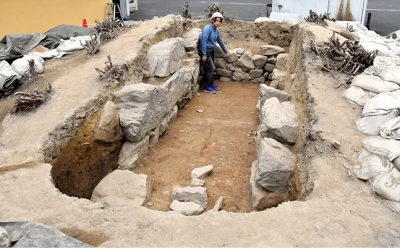 Nara - Shrubbery intended to illuminate a corner of a nondescript parking lot in Japan’s Nara prefecture turned out to be hiding the tomb of an elite figure from ancient times. Archaeologists uncovered numerous artifacts after removing centuries of soil from the stone burial chamber, including two iron swords, arrowheads, items associated with horse riding, amber jewelry, and clay pots. According to researchers from Nara University and the Ikaruga Municipal Board of Education, the chamber, which is about 3.8 meters long, 1.6 meters wide, and 1 meter high, dates to the late sixth century. Archaeologists have been excavating the area located near the World Heritage site encompassing Horyuji temple since spring of 2022, and the ceiling of the tomb found was missing. This prompted the team members to speculate the stones were used to build Horyuji temple, which was completed in the early seventh century. “It is possible the ceiling stones were removed for use in the construction of Horyuji temple and the Ikaruga palace, where Prince Shotoku (an influential political leader of the era) lived with his family,” said Naohiro Toyoshima, a professor of archaeology at Nara University and a member of the research team. “At that point, the stone chamber could have been buried along with all those items,” Toyoshima told the Asahi Shimbun.
Nara - Shrubbery intended to illuminate a corner of a nondescript parking lot in Japan’s Nara prefecture turned out to be hiding the tomb of an elite figure from ancient times. Archaeologists uncovered numerous artifacts after removing centuries of soil from the stone burial chamber, including two iron swords, arrowheads, items associated with horse riding, amber jewelry, and clay pots. According to researchers from Nara University and the Ikaruga Municipal Board of Education, the chamber, which is about 3.8 meters long, 1.6 meters wide, and 1 meter high, dates to the late sixth century. Archaeologists have been excavating the area located near the World Heritage site encompassing Horyuji temple since spring of 2022, and the ceiling of the tomb found was missing. This prompted the team members to speculate the stones were used to build Horyuji temple, which was completed in the early seventh century. “It is possible the ceiling stones were removed for use in the construction of Horyuji temple and the Ikaruga palace, where Prince Shotoku (an influential political leader of the era) lived with his family,” said Naohiro Toyoshima, a professor of archaeology at Nara University and a member of the research team. “At that point, the stone chamber could have been buried along with all those items,” Toyoshima told the Asahi Shimbun.
Ancient tomb discovered under parking lot greenery in Japan - Arkeonews
BULGARIE – 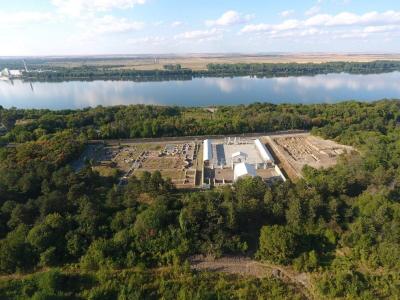
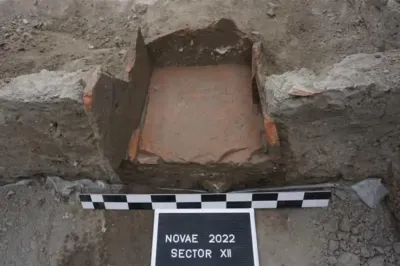 Novae - Lead archaeologist Piotr Dyczek, a professor at the Center for Research on Antiquities of Southeastern Europe at the University of Warsaw, announced that they discovered a new ancient refrigerator with additional cooling at an excavation site near the town of Svishtov (on the Danube), according to a report from Science in Poland – a science news outlet run by the Polish Press Agency. The Novae camp is located in northern Bulgaria, on the Danube, near the city of Svishtov. It was probably founded around the middle of the 1st century AD. The 1st Italian Legion is associated with this place, its presence attested to the 30s of the 5th century AD. Within the camp, which covers 17.99 hectares, monumental buildings were discovered, the most important of which is the camp headquarters (principia), although the legionary hospital (valetudinarium) and baths (thermae legionis) are equally impressive. There was a settlement (canabae) on the western side of the camp and a necropolis on the southern and eastern sides. In the late antique period, the Novae fortifications were strengthened, and an additional area (the so-called annex) was attached to the camp on the eastern side, covering an area of approximately 8 ha. At that time, both soldiers and civilians lived within the walls. Traces of the latest Roman activity come from the end of the 6th century. In this year’s excavation campaign, researchers uncovered a complex of wooden and earth military barracks associated with the VIII Augustus Legion, which was the first to be permanently stationed at the Danube border of the Roman Empire. Scientists took measurements and determined that the structure was thirty-eight meters wide and sixty meters long. The earliest known well in Novae, which supplied the legionaries with water, was discovered here. A system of aqueducts made of ceramic and lead pipes was also found. “At the lead water pipe, a container made of ceramic plates was placed in the ground – so that the pipe ran along its longer side. This is an antique refrigerator, another one that we discovered, but this time with additional cooling. Inside, there were fragments of vessels for drinking wine, bowls, and animal bones. This will allow us to recreate the last meal,” says Professor Dyczek. The exploration of a ceramic furnace from the 4th century brought another discovery in the form of a set of unique vessels, including a wine-drinking set. Rare vessels with a black surface are decorated with a smooth and comb motif. Prof. Dyczek emphasizes that the set can be precisely dated, which is intended to end the experts’ discussion on the chronology and origins of these rare vessels on the Danube. Among the discovered artifacts there is also a small pendant with a representation of a silver, carefully made mouse, refined down to the smallest detail, and over two hundred other souvenirs from the past.
Novae - Lead archaeologist Piotr Dyczek, a professor at the Center for Research on Antiquities of Southeastern Europe at the University of Warsaw, announced that they discovered a new ancient refrigerator with additional cooling at an excavation site near the town of Svishtov (on the Danube), according to a report from Science in Poland – a science news outlet run by the Polish Press Agency. The Novae camp is located in northern Bulgaria, on the Danube, near the city of Svishtov. It was probably founded around the middle of the 1st century AD. The 1st Italian Legion is associated with this place, its presence attested to the 30s of the 5th century AD. Within the camp, which covers 17.99 hectares, monumental buildings were discovered, the most important of which is the camp headquarters (principia), although the legionary hospital (valetudinarium) and baths (thermae legionis) are equally impressive. There was a settlement (canabae) on the western side of the camp and a necropolis on the southern and eastern sides. In the late antique period, the Novae fortifications were strengthened, and an additional area (the so-called annex) was attached to the camp on the eastern side, covering an area of approximately 8 ha. At that time, both soldiers and civilians lived within the walls. Traces of the latest Roman activity come from the end of the 6th century. In this year’s excavation campaign, researchers uncovered a complex of wooden and earth military barracks associated with the VIII Augustus Legion, which was the first to be permanently stationed at the Danube border of the Roman Empire. Scientists took measurements and determined that the structure was thirty-eight meters wide and sixty meters long. The earliest known well in Novae, which supplied the legionaries with water, was discovered here. A system of aqueducts made of ceramic and lead pipes was also found. “At the lead water pipe, a container made of ceramic plates was placed in the ground – so that the pipe ran along its longer side. This is an antique refrigerator, another one that we discovered, but this time with additional cooling. Inside, there were fragments of vessels for drinking wine, bowls, and animal bones. This will allow us to recreate the last meal,” says Professor Dyczek. The exploration of a ceramic furnace from the 4th century brought another discovery in the form of a set of unique vessels, including a wine-drinking set. Rare vessels with a black surface are decorated with a smooth and comb motif. Prof. Dyczek emphasizes that the set can be precisely dated, which is intended to end the experts’ discussion on the chronology and origins of these rare vessels on the Danube. Among the discovered artifacts there is also a small pendant with a representation of a silver, carefully made mouse, refined down to the smallest detail, and over two hundred other souvenirs from the past.
Archaeologists discovered how wine was cooled in Roman legions on the Danube - Arkeonews



